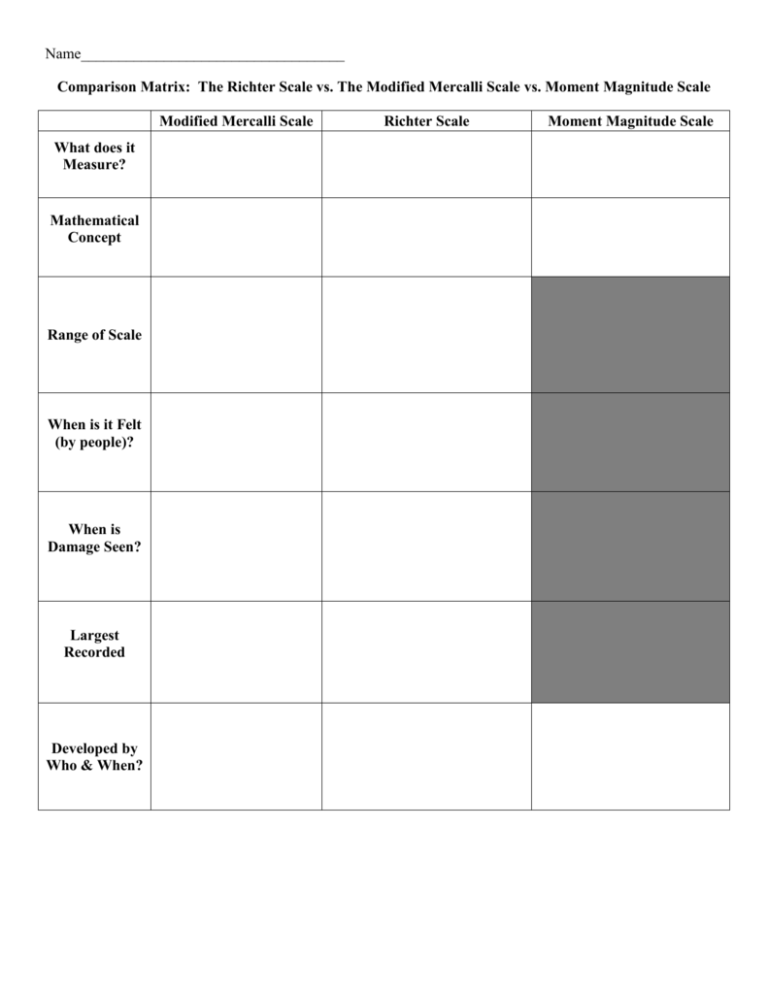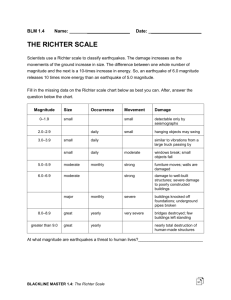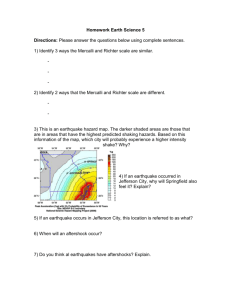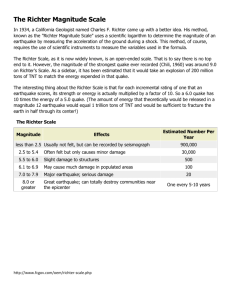Name___________________________________ Comparison
advertisement

Name___________________________________ Comparison Matrix: The Richter Scale vs. The Modified Mercalli Scale vs. Moment Magnitude Scale Modified Mercalli Scale What does it Measure? Mathematical Concept Range of Scale When is it Felt (by people)? When is Damage Seen? Largest Recorded Developed by Who & When? Richter Scale Moment Magnitude Scale Magnitude of an earthquake (energy waves released) Intensity of an earthquake; damage produced by earthquake 1935 by American Charles Richter and German Beno Gutenberg Logarithms (wave amplitude increases by 10 times) 1 – 10 9.5 in Chile (1960) 4 or greater 3 or greater Twelve levels (I – XII) 1883 by Italian Giuseppe Mercalli; modified in 1931 by Americans Wood and Neumann No mathematical basis; based on observations VII and greater XI in San Francisco (1906) II – III or greater Richter Scale Whenever a major earthquake is in the news, you'll probably hear about its Richter Scale rating. You might also hear about its Mercalli Scale rating, though this isn't discussed as often. These two ratings describe the power of the earthquake from two different perspectives. Photo courtesy NGDC Destruction caused by a (Richter) magnitude 6.6 earthquake in Caracas, Venezuela. The 1967 earthquake took 240 lives and caused more than $50 million worth of property damage. The Richter Scale is used to rate the magnitude of an earthquake -- the amount of energy it released. This is calculated using information gathered by a seismograph. The Richter Scale is logarithmic, meaning that wholenumber jumps indicate a tenfold increase. In this case, the increase is in wave amplitude. That is, the wave amplitude in a level 6 earthquake is 10 times greater than in a level 5 earthquake, and the amplitude increases 100 times between a level 7 earthquake and a level 9 earthquake. The amount of energy released increases 31.7 times between whole number values. The largest earthquake on record registered a 9.5 (Chile, 1960) on the currently used Richter Scale, though there have certainly been stronger quakes in Earth's history. The majority of earthquakes register less than 3 on the Richter Scale. These tremors, which aren't usually felt by humans, are called microquakes. Generally, you won't see much damage from earthquakes that rate below 4 on the Richter Scale. Major earthquakes generally register at 7 or above. Photo courtesy NGDC Damage to a school in Anchorage, Alaska, caused by the 1964 Prince William Sound earthquake. The earthquake, which killed 131 people and caused $538 million of property damage, registered a 9.2 on the Richter Scale. Richter ratings only give you a rough idea of the actual impact of an earthquake. As we've seen, an earthquake's destructive power varies depending on the composition of the ground in an area and the design and placement of manmade structures. The extent of damage is rated on the Mercalli Scale. Mercalli ratings, which are given as Roman numerals, are based on largely subjective interpretations. A low intensity earthquake, one in which only some people feel the vibration and there is no significant property damage, is rated as a II. The highest rating, a XII, is applied only to earthquakes in which structures are destroyed, the ground is cracked and other natural disasters, such as landslides or Tsunamis, are initiated. Photo courtesy NGDC Damage from a magnitude 7.4 earthquake that hit Niigata, Japan, in 1964. Richter Scale ratings are determined soon after an earthquake, once scientists can compare the data from different seismograph stations. Mercalli ratings, on the other hand, can't be determined until investigators have had time to talk to many eyewitnesses to find out what occurred during the earthquake. Once they have a good idea of the range of damage, they use the Mercalli criteria to decide on an appropriate rating. The Mercalli scale originated with the widely used simple ten-degree Rossi-Forel scale, which was revised by Italian vulcanologist Giuseppe Mercalli in 1883 and 1902. The terms or Mercalli scale should not be used unless one really means the original ten-degree scale of 1902. In 1902 the ten-degree Mercalli scale was expanded to twelve degrees by Italian physicist Adolfo Cancani. It was later completely re-written by the German geophysicist August Heinrich Sieberg and became known as the Mercalli-Cancani-Sieberg (MCS) scale. The Mercalli-Cancani-Sieberg scale was later modified and published in English by Harry O. Wood and Frank Neumann in 1931 as the Mercalli-Wood-Neumann (MWN) scale. It was later improved by Charles Richter, the father of the Richter magnitude scale. The scale is known today as the Modified Mercalli Scale and commonly abbreviated MM. The effect of an earthquake on the Earth's surface is called the intensity. The intensity scale consists of a series of certain key responses such as people awakening, movement of furniture, damage to chimneys, and finally total destruction. Although numerous intensity scales have been developed over the last several hundred years to evaluate the effects of earthquakes, the one currently used in the United States is the Modified Mercalli (MM) Intensity Scale. This scale, composed of 12 increasing levels of intensity that range from imperceptible shaking to catastrophic destruction, is designated by Roman numerals. It does not have a mathematical basis; instead it is an arbitrary ranking based on observed effects. The Modified Mercalli Intensity value assigned to a specific site after an earthquake has a more meaningful measure of severity to the nonscientist than the magnitude because intensity refers to the effects actually experienced at that place. The lower numbers of the intensity scale generally deal with the manner in which the earthquake is felt by people. The higher numbers of the scale are based on observed structural damage. Structural engineers usually contribute information for assigning intensity values of VIII or above. The following is an abbreviated description of the 12 levels of Modified Mercalli intensity. I. Not felt except by a very few under especially favorable conditions. II. Felt only by a few persons at rest, especially on upper floors of buildings. III. Felt quite noticeably by persons indoors, especially on upper floors of buildings. Many people do not recognize it as an earthquake. Standing motor cars may rock slightly. Vibrations similar to the passing of a truck. Duration estimated. IV. Felt indoors by many, outdoors by few during the day. At night, some awakened. Dishes, windows, doors disturbed; walls make cracking sound. Sensation like heavy truck striking building. Standing motor cars rocked noticeably. V. Felt by nearly everyone; many awakened. Some dishes, windows broken. Unstable objects overturned. Pendulum clocks may stop. VI. Felt by all, many frightened. Some heavy furniture moved; a few instances of fallen plaster. Damage slight. VII. Damage negligible in buildings of good design and construction; slight to moderate in well-built ordinary structures; considerable damage in poorly built or badly designed structures; some chimneys broken. VIII. Damage slight in specially designed structures; considerable damage in ordinary substantial buildings with partial collapse. Damage great in poorly built structures. Fall of chimneys, factory stacks, columns, monuments, walls. Heavy furniture overturned. IX. Damage considerable in specially designed structures; well-designed frame structures thrown out of plumb. Damage great in substantial buildings, with partial collapse. Buildings shifted off foundations. X. Some well-built wooden structures destroyed; most masonry and frame structures destroyed with foundations. Rails bent. XI. Few, if any (masonry) structures remain standing. Bridges destroyed. Rails bent greatly. XII. Damage total. Lines of sight and level are distorted. Objects thrown into the air. I. Instrumental Not felt by many people unless in favorable conditions. II. Feeble Felt only by a few people at best, especially on the upper floors of buildings. Delicately suspended objects may swing. Felt quite noticeably by people indoors, especially on the upper floors of buildings. Many do not recognize it as an earthquake. Standing motor cars may rock slightly. Vibration similar to the passing of a truck. Duration estimated. Felt indoors by many people, outdoors by few people during the day. At night, some awakened. Dishes, windows, doors disturbed; walls make cracking sound. Sensation like heavy truck striking building. Standing motor cars rock noticeably. Dishes and windows rattle alarmingly. Felt outside by most, may not be felt by some outside in nonfavorable conditions. Dishes and windows may break and large bells will ring. Vibrations like large train passing close to house. Felt by all; many frightened and run outdoors, walk unsteadily. Windows, dishes, glassware broken; books fall off shelves; some heavy furniture moved or overturned; a few instances of fallen plaster. Damage slight. Difficult to stand; furniture broken; damage negligible in building of good design and construction; slight to moderate in well-built ordinary structures; considerable damage in poorly built or badly designed structures; some chimneys broken. Noticed by people driving motor cars. Damage slight in specially designed structures; considerable in ordinary substantial buildings with partial collapse. Damage great in poorly built structures. Fall of chimneys, factory stacks, columns, monuments, walls. Heavy furniture moved. General panic; damage considerable in specially designed structures, well designed frame structures thrown out of plumb. Damage great in substantial buildings, with partial collapse. Buildings shifted off foundations. Some well built wooden structures destroyed; most masonry and frame structures destroyed with foundation. Rails bent. Few, if any masonry structures remain standing. Bridges destroyed. Rails bent greatly. Total damage - Almost everything is destroyed. Lines of sight and level distorted. Objects thrown into the air. The ground moves in waves or ripples. Large amounts of rock may move position. III. Slight IV. Moderate V. Rather Strong VI. Strong VII. Very Strong VIII. Destructive IX. Ruinous X. Disastrous XI. Very Disastrous XII. Catastrophic Richter magnitudes Less than 2.0 Description Micro 2.0-2.9 Earthquake effects Frequency of occurrence Microearthquakes, not felt. About 8,000 per day Generally not felt, but recorded. About 1,000 per day Often felt, but rarely causes damage. 49,000 per year (est.) Minor 3.0-3.9 4.0-4.9 Light Noticeable shaking of indoor items, rattling noises. Significant 6,200 per year damage unlikely. (est.) 5.0-5.9 Moderate Can cause major damage to poorly constructed buildings over small regions. At most slight damage to well-designed 800 per year buildings. 6.0-6.9 Strong Can be destructive in areas up to about 160 kilometers (100 mi) across in populated areas. 120 per year 7.0-7.9 Major Can cause serious damage over larger areas. 18 per year Can cause serious damage in areas several hundred miles across. 1 per year Devastating in areas several thousand miles across. 1 per 20 years Never recorded; see below for equivalent seismic energy yield. Extremely rare (Unknown) 8.0-8.9 Great 9.0-9.9 10.0+ Epic Moment Magnitude Scale A newer measurement of the magnitude of earthquakes is the Moment Magnitude scale. It was designed in the 1970s to overcome the problems of the Richter scale. This means that the Moment Magnitude is not comparative, and it is applicable equally everywhere in the world. It is also completely independent of the type of equipment used to measure the earthquake. This new way of measuring the magnitude of earthquakes has become possible through the development of more sophisticated seismology devices than were available to Richter. Seismologists can now directly measure where the rupture in the fault line occurs, and to calculate the energy that is released in the earthquake. This energy is called the seismic moment, the total energy of an earthquake. Moment Magnitude is a calculation based (in part) on the area of the ruptured section of the fault and the distance the earth moved along the fault during the rupture. In order to make a scale comparable to the well-known Richter scale, seismologists invented the (Seismic) Moment Magnitude Scale, which gives magnitudes roughly equivalent to the Richter magnitudes. Both scales are still used, but the Moment Magnitude scale is gradually replacing the Richter scale and is preferred now by most seismologists. The numbers generated by the two scales are usually very similar. For example, the earthquake in Northridge California in 1994 measured 6.4 on the Richter and 6.7 on the Moment Magnitude scale. When reporting the magnitude of an earthquake, many news organizations simply report the earthquake has having a magnitude of [number], without stating whether the Richter or Moment Magnitude scale is being used. For most people, the difference is unimportant. The bigger the number, the worse the earthquake. More About MMS Humans have an innate drive to describe things. Man is a creature of measurement. Science is the answer to man's drive to measure. Size and quantity are inherent to scientific measurement. Numbers make up data. For example, hurricanes are measured by category (1-5) based on wind speed. Tornadoes are measured on the Fujita scale (F1-F5) estimated by damage that is caused. Earthquakes are measured by magnitude (1-10) based on the energy released. Earthquakes occur when tectonic plates slip. This shift causes the Earth to shake. Earthquakes have been reported all through recorded time. In the 1930s, Charles Richter developed a means of comparing California earthquakes on a scale of 1 to 10. Using seismographs and the known epicenter (origin of earthquake), he was able to mathematically form a logarithm that described the earth’s movement. Richter designed his measurement scale to compare California. The fault in this system is the distance between the location of the measuring seismograph and the earthquake’s epicenter. The Richter scale becomes unreliable when the distance exceeds 350 miles. The scale has proved to be excellent with low level earthquakes below 3.0 and adequate for middle level quakes 3.0-7.0. Upper level magnitudes are less precise. Science’s need for more absolute values led a team of Harvard University scientists to develop the Moment Magnitude Scale (MMS). Rather than being based on a comparison scale, it measures earthquakes in terms of energy released. Improved technology allows scientists to relate the earth’s rigidity to the amount of slippage within the area that slippage occurs. As with the Richter scale, the measurement is expressed in logarithms. Using a log scale of 1 – 10, it means that the strength of an earthquake increases 10 fold for each step. For example, the San Francisco earthquake measured 7.9 (MMS). The 2004 Indian Ocean earthquake registered a magnitude of 9.3. The Indian Ocean quake released 14 times the amount of energy than did the San Francisco quake. Earthquake measurement, like measurements for other disasters, are not totally accurate measurements of the effects of the disaster. Other factors not included in the reporting number are the concentration of people, kinds of buildings, soil type and substrate structure. These will have an impact on the disaster levels of an earthquake. The common citizen measures an earthquake on its death toll and property damage. The 1812 New Madrid earthquake measured a magnitude around 8.0. so few lives were lost that there was no record made of the dead. The Shaanxi, China quake of 1556 was estimated to the same magnitude, but cost nearly a million lives. The Moment Magnitude Scale has been adopted by the USGS as its official tool for measuring earthquakes. As a result, the Richter scale has been more or less replaced by the Moment Magnitude Scale. Most earthquakes between 3.0 and 7.0 measure the same on either scale. The scale provides a means to describe how strong an earthquake is, but it does not measure how disastrous the earthquake can be. The Moment Magnitude Scale Moment Magnitude is the measure of total energy released by an earthquake. Moment magnitude is the measurement and term generally preferred by scientists and seismologists to the Richter scale because moment magnitude is more precise. Moment Magnitude is not based on instrumental recordings of a quake, but on the area of the fault that ruptured in the quake. This means that the moment magnitude describes something physical about an earthquake. Moment Magnitude is calculated in part by multiplying the area of the fault's rupture surface by the distance the earth moves along the fault Comparison between the Richter and Moment Magnitude Scales Earthquake Richter Scale Moment Magnitude New Madrid, MO, 1812 8.7 8.1 San Francisco, CA 1906 8.3 7.7 Prince William, AK 1964 8.4 9.2 Northridge, CA,1994 6.4 6.7







